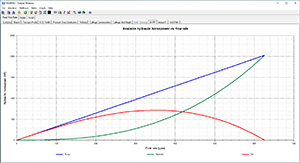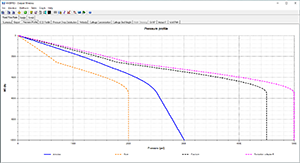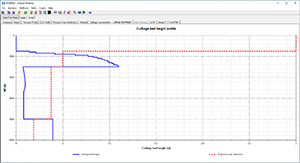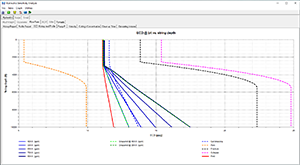 HYDPRO - Drilling Hydraulics Model
HYDPRO - Drilling Hydraulics Model
- Overview
- Features
- Resources
- Specification
Whether you are drilling a vertical or extended-reach well, an equivalent circulating density (ECD) that is too low or too high can cause serious drilling problems or compromise your project’s budget. A successful drilling operation relies heavily on achieving an optimal ECD. Accurate modeling and optimized drilling hydraulics is crucial. It allows engineers to plan ahead, thus improving drilling efficiencies, reducing risk, and decreasing non-productive time (NPT).
Pegasus Vertex's HYDPRO is a comprehensive drilling hydraulics model that covers all aspects of hydraulics, including downhole circulating pressures, surge and swab, ECD, bit optimization, hole cleaning, and volumetric displacements. With these features, downhole drilling hydraulic conditions can be fully examined and any potential problems can be identified prior to field execution.
- Fixed flow rate analysis: pressure, ECD, hole cleaning
- Cuttings concentration
- Bit hydraulics optimization
- Surge and swab
- Hydraulics sensitivity analysis
- Surge and swab speed sensitivity analysis
- Field data comparison on ECD and SPP
- Bingham Plastic, Power Law and Herschel Buckley rheology models
- Land and offshore wells
- 2D animation
- Hydraulics calibration
- 3D well path visualization
- Graph customization
- Microsoft Word® report
- Survey import from Excel®, text or PDF® files
- US oil field, SI and customized units
- Multi-language: English, Spanish, Chinese, Russian and Portuguese
- Screenshots
- Brochures
- FAQ
- Bookstore
Q1. When I perform a hydraulics run, the hole cleaning graphs do not populate. How do I get hole cleaning graphs in the outputs?
To calculate the hole cleaning, select the Advanced (Three-layer) model in the Calculation Setup window. The ROP in the Hydraulics tab must also be greater than 0.
Q2. What do the “RPM effect on hydraulics”, “Eccentricity effect on hydraulics” and “Tool joint effect on hydraulics” options do?
These options affect the hydraulics calculations by accounting for the flow of fluid through restrictions, around and across the tool joint, and in an eccentric annular space. These calculations are complicated, and become even more so with rotation. All the calculations are based on empirical formulas. Any discrepancies, if any, between prediction and field data can give useful insights into the effect of RPM, Eccentricity and tool joint.
Q3. What causes HYDPRO calculation time to increase?
The hydraulics sensitivity analysis can dramatically increase the calculation time, especially when all of the sensitivities are selected.
Surge/swab calculations
The three-layer model uses the iteration method to find the cuttings bed height. It takes the longer to calculate than the API method.
To improve the speed,
- Don’t run the hydraulic sensitivity every time.
- Change the calculation interval to a larger value. The calculation interval defines the bit depth locations at which the pressure profile calculation is conducted. Such as If the calculation interval is set to 500 ft, the program will calculate the hydraulics profile when the bit moves every 500 ft.
Q4. What is the difference between ECD and EMW in Report table in Output Window?
EMW: Equivalent mud weight. It includes the cuttings contribution.
EMW = cuttings density * cuttings concentration + mud weight * (1 – cuttings concentration)
ECD: Equivalent circulation density. It includes the annulus frictional pressure loss.
ECD = EMW + annulus frictional pressure loss/0.052/TVD.
The pressure at bottom is greater than the pressure at surface, but the ECD at bottom might be the same as it at surface.
Q5. Is input setup for calculation matching different in HYDPRO and MUDPRO+?
The mathematical model in HYDPRO and MUDPRO+ are the same. If the inputs are equal, the results should be as well. Differences in the survey/wellpath and small rounding differences in the background of the calculations are likely to occur.
We recommend the calculations between HYDPRO and MUDPRO+ with ECD and PP differences of ≤ 3 % or less than ± 0.3 ppg be considered a match.
Please refer to the .pdf file below for detailed explanation.
HYDPRO and MUDPRO+ Hydraulics Matching Explanation
Q6. How does survey data differ in HYDPRO and MUDPRO+?
HYDPRO allows user to input detailed survey data, while MUDPRO+ uses the MD and TVD from all of the daily reports. It allows HYDPRO surveys to contain more depth entries and therefore often has a more accurate well path for the simulation.
Impact of the survey data tends to be small in PVI’s experience. If the MD and TVD values in MUDPRO+ match the survey data in HYDPRO, the results from both software will be close.
Please refer to the .pdf file below for detailed explanation.
HYDPRO and MUDPRO+ Hydraulics Matching Explanation
Q7. How do the advance options (ROP, RPM, Eccentricity, Tool Joint Consideration) effect HYDPRO/MUDPRO+?
Please refer to the .pdf file below for detailed explanation.
HYDPRO and MUDPRO+ Hydraulics Matching Explanation
Q8. Do I need to turn off Backpressure in HYDPRO for calculation matching to MUDPRO+?
MUDPRO+ does not consider backpressure, so it needs to be turned off in HYDPRO when comparing the ECD and pump pressure calculations.
Please refer to the .pdf file below for detailed explanation.
HYDPRO and MUDPRO+ Hydraulics Matching Explanation
-
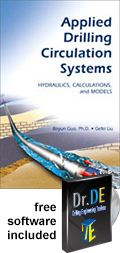
Applied Drilling Circulation Systems, 1st Edition - $90
Hydraulics, Calculations and Models
, published by Elsevier, March 2011.
This book provide users with the necessary analytical/numerical models to handle problems associated with the design and optimization of cost-effective drilling circulation systems. It also provides a clear and rigorous exposition of traditional and non-traditional circulation systems and equipment followed by self contained chapters concerning system modelling applications. Theories are illustrated by case studies based on the author’s real life experience. Drilling and production engineers who need to plan operations including pipe-tripping, running-in casing, and cementing will find this book very useful.
For a limited time, a complimentary 3-month Dr. DE leasing license will be included in any book purchases. Tax, shipping and handling cost will be applied. Contact sales@pvisoftware.com for more information about book purchasing.
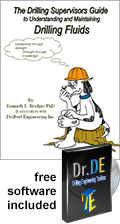
The Drilling Supervisors Guide to Understanding and Maintaining Drilling Fluids - $125
, published by Drilbert Engineering, Inc., 2008
This guide covers virtually every aspect involved in understanding and maintaining drilling fluids. It is intended to give the Drilling Supervisor and the on site Mud Engineer a thorough understanding of drilling mud. The book begins by giving a basic understanding of mud chemistry and polymer chemistry are covered in detail. Calculations for engineering and maintaining the mud are presented in a clear and simple format.The goal of the manual is to enable the rig site supervision to be able to understand and manage the drilling mud programs.Topics include: Functions of Drilling Fluids; Drilling Fluid Properties; Well Bore Stability; Drilling Fluid Components; Drilling Fluid Systems; Solids Control; and more!
For a limited time, a complimentary 3-month Dr. DE leasing license will be included in any book purchases. Tax, shipping and handling cost will be applied. Contact sales@pvisoftware.com for more information about book purchasing.
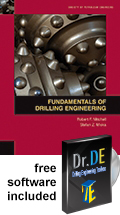
Fundamentals of Drilling Engineering - $190
, published by Society of Petroleum Engineers, 2011
Fundamentals of Drilling Engineering, an update of the classic Applied Drilling Engineering (Textbook Series Vol. 2), takes a new look at the basics of drilling engineering. Chapters are written by experts from industry and academia and provide numerous example problems to reinforce the concepts presented. This book is essential for undergraduate and graduate students, as well as industry professionals trying to gain detailed knowledge of basic drilling concepts.
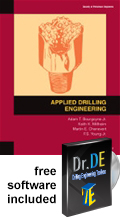
Applied Drilling Engineering - $80
, published by Drilbert Engineering, Inc., 1991
An industry and academic standard, Applied Drilling Engineering presents engineering science fundamentals as well as examples of engineering applications involving those fundamentals. Two appendices are included, along with numerous examples. Answers are included for every end-of-chapter question.
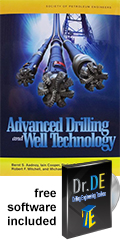
Advanced Drilling and Well Technology - $240
, published by Drilbert Engineering, Inc., 2009
Advanced Drilling and Well Technology captures the vast developments that have occurred in well technology over the past several decades. The 10 chapters focus on applications related to many of the field-related challenges being faced today, such as deepwater and high-pressure/high-temperature wells, as well as emerging technologies like managed pressure drilling, expandable casing, coiled-tubing drilling, and multilateral wells.
-
Operating Systems
- Microsoft Windows® 10 or above
-
Microsoft Office®
- 2016 or above
-
Processor
- Dual core processor, 1.4 GHz or higher. Not compatible with ARM processor
-
Memory
- 4 GB RAM
-
Disk Space
- 200 MB of free disk space for installation
-
Display
- 1,280 x 768 display resolution
-
Installation Options
- Setup file can be accessed from a download link or installation CD provided by PVI


